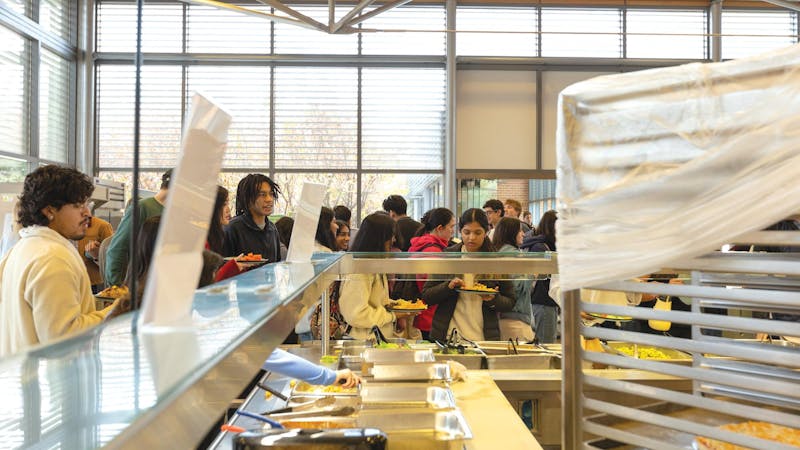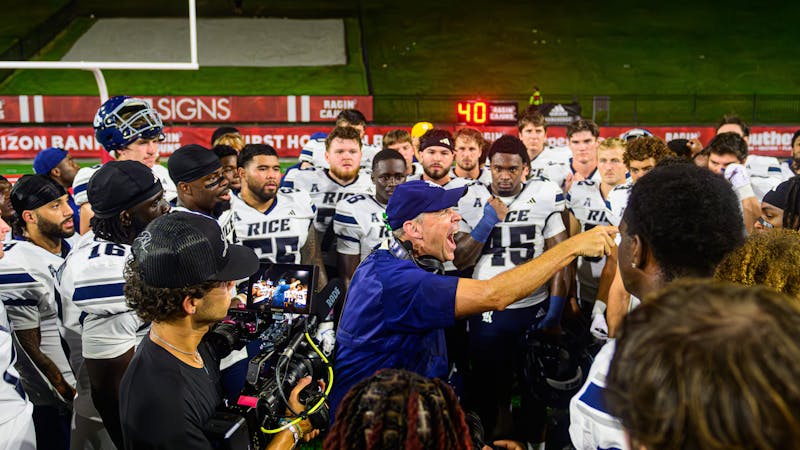Global scholars discuss Judas, scriptures at Codex Judas Congress
Though Rice may have been taken over by the excitement of Willy Week and Beer-Bike, the academic community was focused on another big event on campus last week. The Codex Judas Congress, which was put together by Religious Studies Professor April DeConick, took place Mar. 13-16 in Farnsworth Pavilion, and various buildings across campus. Thirty scholars from around the world came to discuss the recently rediscovered Tchacos Codex, a fourth century collection of Gnostic documents from the Judeo-Christian tradition. In addition to the scholars invited to participate, there were also five papers presented by graduate students, including religious studies graduate students Chad Day, Franklin Trammel and Claire Villarrael. Other graduate students attended as auditors, as did several members of the Houston community.
DeConick said she was pleased with the attendance. The 45 seats set up in Farnsworth for the congress were filled to capacity on Thursday. Likewise, the two evening lectures given to the general public nearly filled McMurtry Hall. DeConick said she estimates the event drew about 200 attendees each night.
The Tchacos Codex, particularly the Gospel of Judas it contains, is very important in the scholarly community at the moment. These texts reveal the self-perception of a "heretical" religious community that had previously been known only through the condemnation of early church fathers like Irenaeus.
One of the few unanimous conclusions of the congress was that the Gospel of Judas condemned the church fathers.
"This text is a polemical text of the mainstream or apostolic church, especially in terms of its sacraments," DeConick said.
She said the Eucharist was a topic of contention between the two groups with Baptism likely to follow once the missing pieces of the text are put into place.
The Gospel of Judas contains stories of Jesus laughing at the disciples and their inability to understand him, as well as a description of the world as rather bleak. Gnostics, including those who wrote this text, saw the creator God as evil, and sought to escape this universe and return to the true God beyond the created realm.
The sensationalism of the Gospel of Judas has been further heightened by National Geographic, which was given the Tchacos Codex for translation and preservation. Despite the fact that the codex they were given had been reduced to scattered fragments over the last 17 years, a process that DeConick described as heartbreaking, National Geographic was able to release a translation of the Gospel of Judas in April 2006. In order to maintain surprise and excitement, National Geographic required non-disclosure agreements from all those working on the text.
While this worked as a business model, it caused a stir in the academic community. Not only did the non-disclosure agreement prevent the normal process of peer review, but the tight schedule required by the simultaneous release of various media meant that fragments of the text were still being pieced back together while the book was already in print. This meant that the original product lacked the polish of a typical academic work because it did not have a chance to go through any rigorous editing.
DeConick said this inadequate translation is what originally caught her eye. She said she decided quickly that she needed to organize scholarship of the work and promote debate. She began work on this congress almost two years ago by sending out some informal e-mails to gauge the interest level.
"I got positive responses from 99 percent of the people that I sent things to, and it just sort of grew from there," DeConick said.
At the same time, DeConick began writing her own book, The Thirteenth Apostle, which criticized the translation and interpretation of those working for National Geographic. Although they had originally seen Judas in a positive light, DeConick said she saw quite the opposite. In her book, she argued that several key passages cast Judas as a demon. At least one of these passages was edited into the book at the last minute because it was recovered while the book was already at print, which did not leave time for reinterpretation on the part of the original translators.
DeConick said two of the main accomplishments of the congress are direct responses to the problems of translation present in the original presented by National Geographic. The first of these is procedural. She said that the scholars in attendance were unanimously against the use of non-disclosure agreements. She said scholarship is not a commodity and while groups like National Geographic do great work in financing such activities and ensuring the preservation of ancient texts, the corporate model needs to be adapted to allow for both peer review and adequate time.
DeConick said this is not so much a criticism of National Geographic as it is a statement about the difficulties in fitting expensive academic work into the capitalistic model. She said it remains to be seen how this can be worked out between scholars and businessmen.
DeConick said the second major accomplishment was the move among her peers towards the acceptance of Judas as a demonic figure in the Gospel of Judas.
"I think we're seeing a real shift in scholars' opinions on the portrait of Judas," DeConick said. "They seem to move more in the negative direction, with a large contingent saying, 'He's a villain in this text.'"
DeConick said those who originally saw Judas in a positive light are shifting toward the ambiguous or the undetermined. She said only one scholar argued for Judas as a hero at the conference.
The conference was also greatly aided by the National Geographic's timely release of photographs showing the original papyri as they have been reconstructed.
"The papers that were delivered at this conference, I think quality-wise, are far superior to the others because they're working from the photographs, from the correct transcription," DeConick said.
As a whole, the congress has been very well received. DeConick said one observer approached her after a session to say that he thought history was being made at the conference. DeConick said she agreed.
"This congress, I think, moved forward our knowledge of the material by leaps and bounds," DeConick said.
She added that the energy and excitement provided by the conference should push scholars to continue to explore the Tchacos Codex after they return home.
Despite the progress made during this congress, DeConick said a lot of work remains to be finished. Numerous fragments are still at large, and even National Geographic still has to place pieces in their proper order.
"The next thing we've got to do is finish reconstructing this thing," DeConick said.
The papers delivered at the conference will be collected in a compilation scheduled for release in 2009.
More from The Rice Thresher

Over 1,000 students petition against new meal plan
When Konstantin Savvon opened the Housing and Dining email announcing the new unlimited meal plan, he was instantly concerned about the impact on off-campus students like himself.

Rice football wins season opener under new coach
For the first time since 2018, Rice football opened its season with a victory. Scott Abell was soaked with yellow Powerade following a 14-12 win on the road Saturday against the University of Louisiana at Lafayette, which won 10 games and made it to the Sun Belt Conference championship last season.

Acting like an athlete: Rice basketball alum takes on Broadway
Underneath Chadd Alexander’s Broadway costume, there’s ankle tape and wrist braces — same protective gear he wore as a walk-on basketball player at Rice, though now he’s performing eight shows a week in the ensemble of “Harry Potter and the Cursed Child” instead of running conditioning drills in Tudor Fieldhouse.

Please note All comments are eligible for publication by The Rice Thresher.